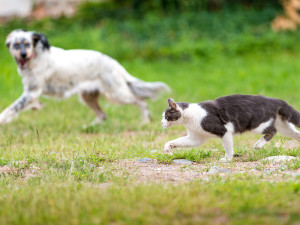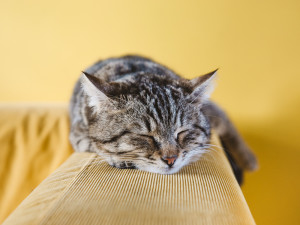Daylight Saving Time Confuses Pets, Too
Animal behaviourist Karen London on how ‘springing forward’ causes your dog or cat to lose sleep, too

share article
One the Easter weekend, millions of people will lose an extra hour of sleep, courtesy of the switch to daylight saving time from standard time. When the clocks change from standard time, known as Greenwich Mean Time (GMT), to daylight saving time, known as British Summer Time (BST), we all lose an hour of sleep, including our pets.
Daylight saving time is an outdated and unhealthy human construct, and many animals are having no part of it. Dogs and cats follow their circadian rhythms.
What is circadian rhythm?
Pets are inclined to be active at certain times of the day just as birds are inclined to sing at sunrise and bats come out during the night. The tendency to behave in certain ways over the course of the day is part of the daily cycle called a circadian rhythm.
These internal clocks override our ridged time schedules, so many dogs (and many more catsopens in a new tab) will probably get up at the crack of dawn, as usual, ready to start the day.
The light/dark cycle of our rotating planet is responsible for the circadian rhythms that lead to the predictable timing of behaviours throughout the day. Light leads to changes in the hypothalamus, which regulates these daily rhythms. The pattern of light affects sleep cycles, hormone levels, brain wave activity and body temperature, all of which have an impact on behaviour.
Helping your pet adjust to the time change
When the time shifts, pets are generally confused, and we have no way to explain this to them. Here are a couple of ways you can help your dog or cat adapt.
Keep a routine
It’s typical for pets to need a couple of days to adjust after the time change, but some take longer than others. Pets with a strong internal clock are heavily influenced by sunrise, sunset and predictable feelings of hunger. As those cues still happen, pets who respond to them tend to struggle with the new schedule. Some dogs are also highly schedule oriented, but they respond to human cues – the alarm clock, people getting out of bed, the sound of food being put in the bowl – and they are often able to adapt more quickly to humans messing around with clocks.
Take it slow
It can be helpful to pets to meet them in the middle as they adjust to the time change. It may be easier if you can break up the hour difference and only adjust their schedule – walks, feeding time, bedtime and waking up – by 15–30 minutes each day. If your schedule does not allow that kind of flexibility or you find that your dog gets in line with the new daily rhythm within a few days anyway, it may not be worth the extra effort. But, for the rare dog who struggles for a long time with the time change, breaking up the hour into smaller pieces for a more gradual adjustment can be a great kindness.
It can be tough for some pets (and let’s be real, for some people, too) to adapt, so build in room for an adjustment period. Giving them a few extra minutes to take care of business might be all it takes to get them acclimated to the abrupt change in schedule.

Karen B. London, PhD, CAAB, CPDT-KA
Karen B. London, Ph.D., is a Certified Applied Animal Behaviorist and Certified Professional Dog Trainer who specializes in working with dogs with serious behavioral issues, including aggression, and has also trained other animals including cats, birds, snakes, and insects. She writes the animal column for the Arizona Daily Sun and is an Adjunct Professor in the Department of Biological Sciences at Northern Arizona University. She is the author of six books about training and behavior, including her most recent, Treat Everyone Like a Dog: How a Dog Trainer’s World View Can Improve Your Lifeopens in a new tab.
Related articles
![Cat running in the foreground outside with a dog out of focus running in the background]() opens in a new tab
opens in a new tabWhy Are Cats More Flexible Than Dogs?
We all have our talents
- opens in a new tab
Cats vs Dogs: Exploring Feline Intelligence and Canine IQ
A common (if not silly) question with a complicated answer
![Cat napping on a yellow couch against a yellow background]() opens in a new tab
opens in a new tabDoes My Cat Have Spots?
Pimples and spots can be unsightly and painful – here’s how to treat your cat’s acne
![Dog hiding under the sofa and afraid to go out because he heard fireworks.]() opens in a new tab
opens in a new tabWhy Are Dogs Scared of Fireworks?
How to keep your dog mentally and physically safe this Bonfire Night




